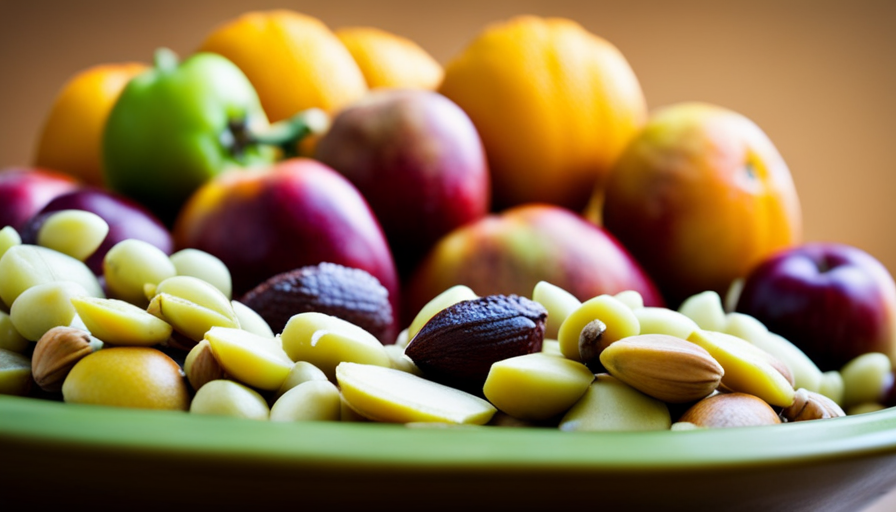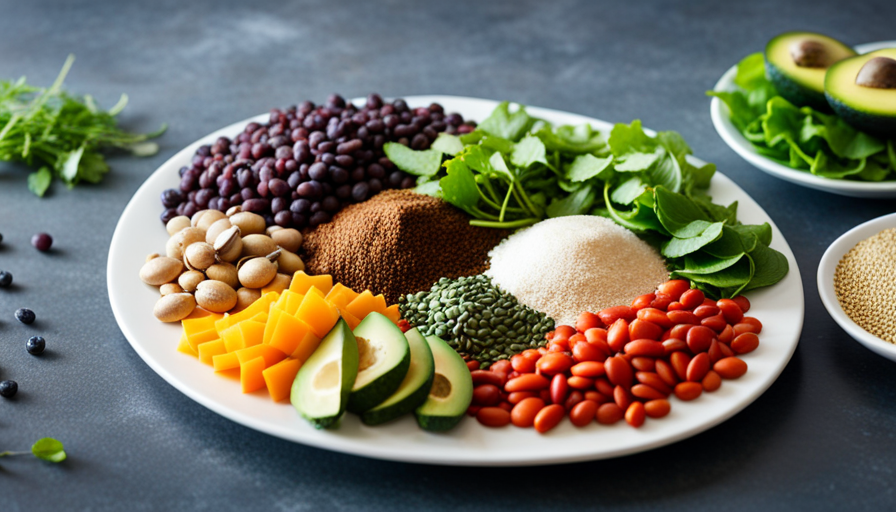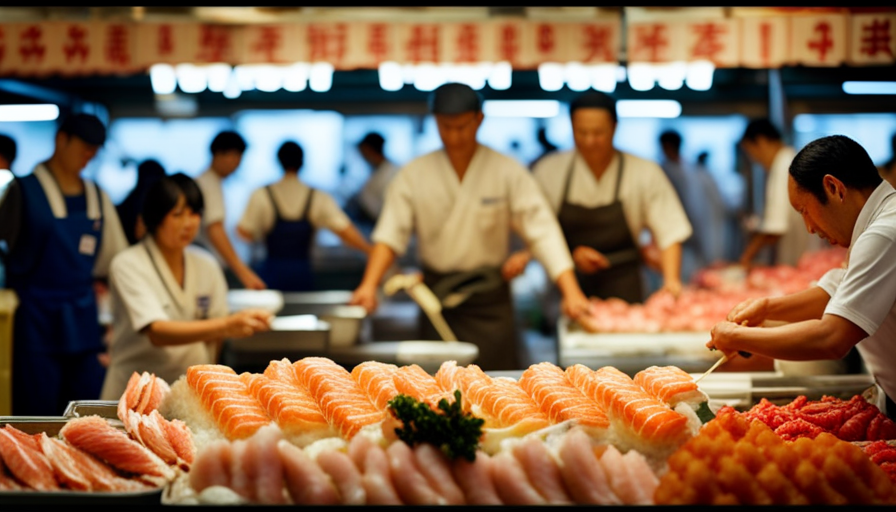Are you ready to dive into the world of raw cuisine? Picture biting into a juicy, crunchy apple or savoring the creamy texture of a perfectly ripe avocado. Eating a diet consisting of uncooked foods can provide numerous health benefits such as increased energy and improved digestive health. One common challenge, however, is getting enough calories on this type of diet. But don’t worry, it is possible to meet your calorie requirements while following a raw food lifestyle. In this article, we will explore effective strategies to ensure you are getting enough calories. We will cover everything from incorporating calorie-dense raw foods into your meals to maintaining a balanced intake of macronutrients. Join us on this journey and discover how to properly fuel your body with the calories it needs through a raw food diet.
Key Takeaways
- Understanding your metabolic rate and activity level is crucial for determining your caloric needs on a raw food diet.
- Incorporating high-calorie raw foods like avocados, almonds, and coconut milk can help increase calorie intake.
- Healthy fats, such as avocados and nuts, play a vital role in brain health, reducing inflammation, and providing concentrated energy.
- Balancing macronutrients, including plant-based protein sources and carbohydrates, is important for optimal caloric intake on a raw food diet.
Understanding Calorie Needs on a Raw Food Diet
If you’re wondering how to meet your calorie needs on a raw food diet, we’ve got you covered! Understanding your metabolic rate and caloric needs in different activity levels is key to ensuring you get enough calories on this diet.
First, let’s talk about your metabolic rate. This is the amount of energy your body needs to carry out basic functions like breathing, circulating blood, and digesting food. It varies from person to person and is influenced by factors like age, gender, and genetics. To get a rough estimate of your metabolic rate, you can use online calculators or consult a registered dietitian.
Next, consider your activity level. If you lead a sedentary lifestyle, meaning you have minimal physical activity, you’ll need fewer calories compared to someone who is moderately or highly active. Take into account the type and duration of your exercise when calculating your caloric needs.
Once you have an idea of your metabolic rate and activity level, you can determine your daily caloric needs on a raw food diet. Aim to consume a variety of fruits, vegetables, nuts, and seeds to ensure you’re getting a good balance of macronutrients. Don’t be afraid to add healthy fats like avocados and olive oil to increase your calorie intake. Remember, it’s important to listen to your body and adjust your portion sizes accordingly.
By understanding your metabolic rate and caloric needs in different activity levels, you can ensure that you’re getting enough calories on a raw food diet. Don’t forget to consult with a healthcare professional or registered dietitian to tailor your diet to your specific needs.
Incorporating High-Calorie Raw Foods into Your Diet
By incorporating nutrient-rich, power-packed ingredients, you can ensure an abundant energy source while following a natural and wholesome eating plan. One way to boost your calorie intake on a raw food diet is by incorporating high-calorie smoothies into your daily routine. These smoothies can be made by combining fruits, vegetables, and healthy fats like avocados or nuts. For example, a smoothie made with bananas, almond butter, and coconut milk can provide a significant calorie boost.
Another great way to increase your calorie intake is by incorporating dried fruits into your meals. Dried fruits are concentrated sources of calories and can be easily added to salads, oatmeal, or even eaten as a snack. Dates, figs, and raisins are all excellent options.
To make it easier for you to incorporate high-calorie raw foods into your diet, here’s a table with some examples of calorie-dense ingredients:
| Ingredient | Calories per 100g |
|---|---|
| Avocado | 160 calories |
| Almonds | 576 calories |
| Coconut milk | 230 calories |
| Dates | 282 calories |
| Raisins | 299 calories |
By including these ingredients in your meals and snacks, you can easily meet your calorie needs on a raw food diet while enjoying delicious and nutritious foods.
The Importance of Healthy Fats in a Raw Food Diet
Incorporating healthy fats is crucial for a raw food lifestyle, as they provide essential nutrients and promote overall well-being. When following a raw food diet, it’s important to ensure that you’re getting enough calories to sustain your energy levels. Healthy fats can help with this, as they’re more calorie-dense than other macronutrients. Here are some nutritional benefits of healthy fats on a raw food diet:
- Healthy fats, such as avocados and nuts, are rich in monounsaturated and polyunsaturated fats, which are essential for brain health and reducing inflammation.
- They provide a concentrated source of energy, helping you meet your caloric needs.
- Healthy fats are also important for the absorption of fat-soluble vitamins, such as vitamin A, D, E, and K.
- They can help regulate hormones and support a healthy metabolism.
When it comes to incorporating healthy fats into your raw food diet, here are some of the best sources:
- Avocado: This fruit isn’t only delicious but also packed with healthy fats.
- Nuts and seeds: Almonds, walnuts, chia seeds, and flaxseeds are all great options.
- Coconut: Whether it’s coconut oil, coconut meat, or coconut milk, this tropical treat is a fantastic source of healthy fats.
- Olives: Adding olives or cold-pressed olive oil to your meals can provide a dose of healthy fats.
By including these sources of healthy fats in your raw food diet, you can ensure that you’re getting enough calories and reaping the nutritional benefits they offer.
Balancing Macronutrients for Optimal Caloric Intake
To maximize your energy levels and overall well-being, it’s essential to find the right balance of macronutrients in your raw food lifestyle. Understanding protein sources and incorporating carbohydrates effectively are two key factors in achieving this balance.
When it comes to protein sources on a raw food diet, it’s important to diversify your options. While most people think of animal products as the primary source of protein, there are plenty of plant-based options available. Foods like nuts, seeds, legumes, and leafy greens can provide you with the protein you need to support muscle growth and repair. Incorporating a variety of these plant-based protein sources into your meals will ensure that you’re getting all the essential amino acids your body needs.
In addition to protein, carbohydrates are another important macronutrient to consider. Raw fruits and vegetables are excellent sources of carbohydrates and should make up a significant portion of your daily caloric intake. These foods provide essential vitamins, minerals, and fiber, while also supplying your body with the energy it needs to function optimally.
By understanding protein sources and incorporating carbohydrates effectively, you can ensure that you’re getting enough calories on a raw food diet. Remember to vary your protein sources and focus on consuming a wide range of raw fruits and vegetables to support your overall health and well-being.
Boosting Caloric Density with Nut and Seed Butters
If you want to amp up the energy in your meals, try adding a generous dollop of nut or seed butter to your favorite dishes. Not only will this boost the flavor, but it’ll also increase the caloric density of your meal.
Nut and seed butters are not only delicious, but they’re also packed with essential nutrients that can help you meet your caloric needs on a raw food diet.
One of the benefits of adding nut or seed butter to your meals is that it can help boost your protein intake. Nuts and seeds are excellent sources of plant-based protein, which is important for muscle growth and repair. By incorporating nut or seed butter into your meals, you can ensure that you’re getting enough protein to support your active lifestyle.
In addition to boosting protein intake, nut and seed butters can also provide you with healthy carbohydrates. Carbohydrates are an important source of energy, especially on a raw food diet where the majority of your calories come from carbohydrates. By adding nut or seed butter to your meals, you can increase your carbohydrate intake and ensure that you have enough energy to fuel your activities throughout the day.
So, whether you’re looking to increase your protein intake or incorporate more healthy carbohydrates into your diet, nut and seed butters are a great option. Just remember to choose natural, unsweetened varieties to keep your meals as nutritious as possible.
Maximizing Calorie Absorption through Proper Food Combining
Boost your body’s calorie absorption by properly combining the foods you eat, like how mixing the right ingredients in a recipe creates a delicious and satisfying meal. Maximizing nutrient absorption through proper food combining can help you get the most out of your raw food diet. When you combine certain foods, you can enhance digestion and increase the absorption of essential nutrients.
Digestive enzymes play a crucial role in breaking down food and maximizing nutrient absorption. By combining foods that require similar digestive enzymes, you can optimize their effectiveness. For example, pairing fruits with other fruits or eating leafy greens with other vegetables can improve digestion and nutrient absorption.
To help you visualize how to properly combine foods, consider the following table:
| Category | Compatible Foods | Incompatible Foods |
|---|---|---|
| Fruits | Apples, bananas, berries | Citrus fruits, melons, avocados |
| Leafy greens | Spinach, kale, lettuce | Cabbage, broccoli, cauliflower |
| Nuts and seeds | Almonds, walnuts, flaxseeds | Peanuts, cashews, sunflower seeds |
| Starches | Sweet potatoes, quinoa, oats | Rice, pasta, bread |
| Protein sources | Lentils, beans, tofu | Meat, dairy, eggs |
By following proper food combining principles, you can maximize the absorption of calories and essential nutrients from your raw food diet. Remember to listen to your body and experiment with different combinations to find what works best for you.
Sneaky Ways to Add Extra Calories to Raw Meals
One clever trick for adding extra calories to your raw meals is by sneaking in nutrient-dense ingredients that pack a flavorful punch. When it comes to adding sweeteners, opt for natural options like dates, agave nectar, or coconut sugar. These sweeteners not only add a touch of sweetness to your dishes but also provide additional calories. You can use them in smoothies, dressings, or even as a topping for raw desserts.
Incorporating protein sources is another great way to boost the calorie content of your raw meals. Nuts and seeds are excellent options as they not only provide protein but also healthy fats. Sprinkle some crushed almonds or pumpkin seeds on your salads or blend them into your smoothies for a nutrient-rich calorie boost. You can also consider adding some plant-based protein powders like hemp or pea protein to your recipes.
Additionally, avocados are a fantastic ingredient to add extra calories to your raw meals. They’re rich in healthy fats and can be easily incorporated into smoothies, salads, or even used as a base for creamy dressings. Another idea is to use coconut oil or nut butters in your recipes. These ingredients are high in calories and can be used as spreads, dressings, or even as a base for energy balls or bars.
By incorporating these sneaky tricks, you can easily add extra calories to your raw meals without compromising the nutritional value.
Avoiding Common Caloric Pitfalls on a Raw Food Diet
Now that you’ve learned some sneaky ways to add extra calories to your raw meals, let’s talk about avoiding common caloric pitfalls on a raw food diet. It’s important to ensure you’re getting enough calories to meet your body’s needs while following a raw food lifestyle.
-
Creating satisfying raw food meals: One common misconception about raw food diets is that they’re bland and unsatisfying. However, with a little creativity, you can create delicious and satisfying meals that are also packed with nutrients. Incorporate a variety of fruits, vegetables, nuts, and seeds to add flavor, texture, and satiety to your meals. Experiment with different combinations and seasonings to keep your taste buds excited.
-
Addressing common misconceptions: Another misconception is that raw food diets lack essential nutrients and can lead to deficiencies. While it’s true that some nutrients may be more challenging to obtain from raw food sources, it’s not impossible. By ensuring a diverse and balanced diet, you can meet your nutritional needs on a raw food diet. Consider incorporating foods like sprouts, seaweed, fermented foods, and superfoods to boost your nutrient intake.
By being mindful of these discussion ideas and incorporating them into your raw food diet, you can create satisfying meals while addressing common misconceptions about the diet. Remember, it’s important to listen to your body’s hunger and fullness cues and adjust your portion sizes accordingly.
Listening to Your Body’s Hunger and Fullness Cues
Tune in to your body’s signals and let your senses guide you in deciding when to eat and when to stop, ensuring a harmonious relationship with your body’s hunger and fullness cues on your raw food journey. Mindful eating is a key aspect of developing better hunger and fullness awareness. By paying attention to how your body feels before, during, and after meals, you can become more attuned to its needs.
One strategy for practicing mindful eating is to slow down and savor each bite. Take the time to chew your food thoroughly and appreciate its flavors and textures. This allows your body to properly digest and absorb the nutrients, while also giving your brain time to recognize when you’re satisfied.
Another helpful technique is to check in with your emotions before reaching for food. Emotional eating can be a common pitfall on a raw food diet, as it can be tempting to use food as a way to cope with stress or other negative feelings. Instead, try finding alternative ways to address your emotions, such as going for a walk, practicing deep breathing, or engaging in a hobby you enjoy.
By practicing mindful eating and finding strategies to overcome emotional eating, you can develop a healthier relationship with your body’s hunger and fullness cues. This will ensure that you’re getting enough calories on your raw food diet while also nourishing your body and mind.
Seeking Professional Guidance for Individualized Caloric Needs
To ensure you’re meeting your unique caloric needs, it’s advisable to seek professional guidance from a nutritionist or dietitian. These experts can provide personalized nutrition advice that takes into account your individual preferences, health goals, and lifestyle.
Here are some reasons why seeking professional guidance is important:
-
Expertise: Nutritionists and dietitians have extensive knowledge and training in the field of nutrition. They can assess your current dietary intake and help you determine the appropriate number of calories you need to consume on a raw food diet.
-
Individualized approach: Everyone’s caloric needs are different, and a nutritionist or dietitian can help you tailor your raw food diet to meet your specific requirements. They can take into account factors such as your age, sex, activity level, and any underlying medical conditions.
-
Nutrient balance: A raw food diet can be nutrient-dense, but it may also be lacking in certain nutrients if not properly planned. Seeking professional guidance ensures that you’re getting all the essential vitamins, minerals, and macronutrients your body needs.
-
Long-term sustainability: A nutritionist or dietitian can help you create a balanced and sustainable raw food meal plan that meets your caloric needs. They can provide ongoing support and guidance to help you stay on track and make adjustments as needed.
By seeking professional guidance, you can ensure that you’re getting enough calories on a raw food diet while also meeting your nutritional needs for optimal health and well-being.
Frequently Asked Questions
Can I get enough protein on a raw food diet?
On a raw food diet, you can absolutely meet your protein requirements. There are plenty of protein sources available to you, such as nuts, seeds, legumes, and leafy greens. These foods not only provide protein but also essential vitamins and minerals. Incorporating a variety of these protein-rich foods into your meals will help ensure you’re getting enough protein to support your body’s needs.
So, don’t worry, you can easily meet your protein needs on a raw food diet.
What are some high-calorie raw food options for breakfast?
To get a high-calorie breakfast on a raw food diet, try making raw food smoothies with nuts and seeds. Blend together a handful of almonds or cashews, a tablespoon of chia seeds or flaxseeds, and some fresh fruits like bananas or berries. These ingredients are packed with healthy fats, protein, and fiber, which can help you feel satisfied and energized throughout the morning. Experiment with different combinations to find your favorite raw food smoothie recipe.
How can I add healthy fats to my raw food diet?
To maintain a balanced vegan diet while adding healthy fats to your raw food diet, you have several options. One interesting statistic to consider is that avocados are an excellent source of healthy fats, containing about 21 grams per fruit. You can incorporate avocados into your raw food diet by adding them to salads, spreading them on raw crackers, or blending them into smoothies.
Other healthy fat sources include nuts, seeds, and coconut oil.
Is it possible to gain weight on a raw food diet?
Yes, it’s possible to gain weight on a raw food diet. While this diet is often associated with weight loss due to its high nutrient content and low calorie density, it’s still possible to consume more calories than your body needs. To promote weight gain, focus on incorporating calorie-dense foods like nuts, seeds, avocados, and coconut into your diet. However, be cautious of nutrient deficiencies that may arise from a limited variety of foods.
Are there any specific combinations of foods that can help maximize calorie absorption on a raw food diet?
To maximize calorie absorption on a raw food diet, certain food combinations can help. One interesting statistic is that combining a source of fat, like avocado or nuts, with leafy greens can increase the absorption of fat-soluble vitamins.
Additionally, pairing foods rich in vitamin C, such as citrus fruits, with iron-rich foods like spinach can enhance iron absorption.
These tips can ensure you’re getting the most out of your raw food diet in terms of calorie absorption and nutrient intake.
How Can I Ensure I’m Getting Enough Calories on a Raw Food Diet, Especially with Freeze Dried Food?
Figuring out raw freeze dried food量 is crucial for ensuring you’re getting enough calories on a raw food diet. Focus on calorie-dense options like nuts, seeds, and dried fruits. Incorporating healthy fats like avocados and coconut oil can also help increase your calorie intake.
Conclusion
In conclusion, now that you have a better understanding of how to get enough calories on a raw food diet, you can confidently embark on this healthy lifestyle. By incorporating high-calorie raw foods, such as avocados and nuts, and balancing your macronutrients, you can ensure optimal caloric intake.
Don’t forget the importance of healthy fats in your diet, as they provide essential nutrients and help you feel satisfied. And if you ever find yourself needing an extra calorie boost, nut and seed butters can come to your rescue.
Remember, Rome wasn’t built in a day, so be patient with yourself as you navigate this new way of eating. And most importantly, listen to your body’s hunger and fullness cues, as they will guide you on your raw food journey. Seek professional guidance if needed to tailor your caloric needs to your individual requirements.
Happy raw eating!










